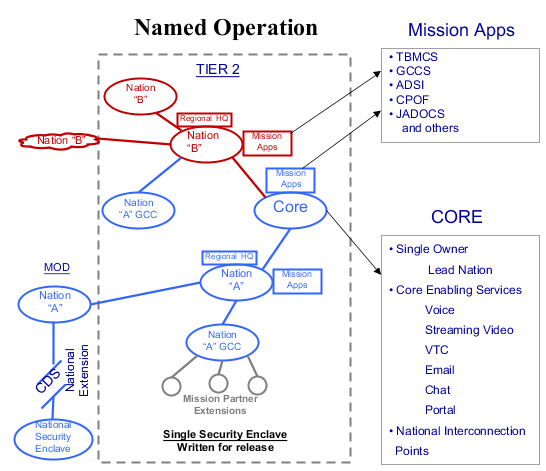Appendix H. The Combined Endeavor Mission Network (CEMN) Profile of NATO Interoperability Standards
H.1. Purpose
|
COMBINED ENDEAVOR (CE) is a Joint Chiefs of Staff (JCS) directed exercise consisting of a series of C4 related interoperability conferences and an exercise planned among NATO, NATO members, PfP nations and other organizations/formations within the NATO/PfP and invited nations framework who have their own C4 equipment. It follows a multiyear, collaborative process in an interactive, team-building environment with representatives from participating nations and organizations to design and execute an annual interoperability exercise |
||
| --USEUCOM J6 | ||
|
For CE13, a Future Mission Network (FMN) management approach and real world Afghanistan Mission Network (AMN) experiences will be used to Plan, Govern, and Execute CE13. This will migrate CE from a multinational interoperability exercise to a mission focused coalition operation. All CE13 goals will be consistent with having NATO as a mission Partner as well as a mission Lead. EUCOM’s goal is to transform CE into an enduring multinational FMN trial event to improve the Speed and Effectiveness of ourselves and our partners in conducting coalition operations |
||
| --USEUCOM J6 | ||
384. NATO, through its interoperability directive, has recognized that widespread interoperability is a key component in achieving effective and efficient operations. In many of the operations world-wide in which NATO nations are engaged, they participate together with a wide variety of other organizations on the ground. Such organizations include coalition partners from non-NATO nations, Non-Governmental Organization (NGOs - e.g. Aid Agencies) and industrial partners. The NATO Interoperability Standards and Profile (NISP) provides the necessary guidance and technical components to support project implementations, exercises and transition to NATO Network Enabled Capability (NNEC).
385. The figure CEMN Information Environment characterizes the information environment and various scenarios that exist for exchanging operational information. This environment, although rich in participation and basic connectivity, lacks fully meshed interoperability at the services layer. This diagram represents the CEMN environment, and the starting point for nations and NATO to plan for participation in Combined Endeavor 13. Future CE exercises will submit updates to this Annex as appropriate. It is presumed for the purposes of this document that the CEMN Profile will only address capabilities between the CEMN Core and national extensions.

386. The purpose of this document is to define an Interoperability Standards Profile to support Combined Endeavor and transition from today's legacy systems to a federated networked environment by defining a useful level of interoperability.
387. This document will also serve as a resource for NATO and national C4ISR planners, to be used as a guide in achieving interoperability among NATO nations, coalition partners and NATO provided capabilities who participate in Combined Endeavor. The CEMN Profile is for use throughout the complete lifecycle of the Future Mission Network framework as exercised by Combined Endeavor. The CEMN Profile will enable Net Centric operations by enhancing collaboration across the entire operational environment across all levels of command. Subsequent missions involving NATO and NATO nations will benefit from the modular nature of the CEMN Profile, which will allow for maximum reuse of established capabilities, while accommodating unique requirements and technology improvements.
388. Additional benefits to deployment and sustained operations include:
-
Speed of execution of operations,
-
Richer information environment,
-
More dynamic information exchange between all members of the network,
-
Speedier standup of an NATO-led operation,
-
Reach-back to feature rich information enterprise(s), and
-
Elimination of hierarchical information flow.
389. Participating nations are encouraged to use this document as part of the planning process for coordination and establishment of connectivity and interoperability with respect to joint/coalition NATO-led operations.
390. Nations participating in CEMN agree to use this profile at Network Interconnection Points (NIPs) and at other Service Interoperability Points as applicable.
391. Net-enabled Services must be able to function in a network environment containing firewalls and various routing and filtering schemes; therefore, developers must use standard and well-known ports wherever possible, and document non-standard ports as part of their service interface. Service developers must assume network behavior and performance consistent with the existing limits of these networks, taking bandwidth limitations and potentially unreliable networks into account.